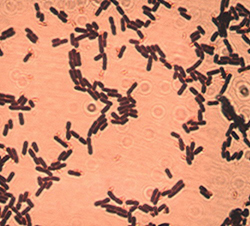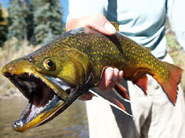
Continuous vigilance is necessary to prevent new or emerging diseases from entering the state and threatening the health of aquaculture and free-ranging fish populations. The Aquatic Animal Health Lab staff maintains a network of contacts with federal and other state fish pathologists and also monitors news releases and announcements concerning potential disease threats. At the present time, several emerging diseases are being watched carefully, and we are working to put biosecurity measures in place to prevent their entry into Colorado.
The following are diseases and issues that the AAHL is currently monitoring:
Viral hemorrhagic septicemia virus (VHSV)
Where is it? Until recently, this disease was known to occur only in Europe in rainbow trout and turbot and along the Pacific Coast of North America in Pacific herring and pilchard. Since 2003, a new and highly virulent strain of the virus has been identified in the Great Lakes region. The virus has not yet been detected in Colorado.
Risks: The virus, particularly the new strain, threatens to kill substantial populations of multiple species of game and native fish. The AAHL continues to perform statewide surveillance for presence of the virus, and state regulations have been strengthened to prevent introduction of the virus into state waters. For more information, check out the Viral Hemorrhagic Septicemia Brochure.
Largemouth bass virus (LMBV)
 Where is it? This is a viral disease of fish occurring in the southeastern and eastern United States. The virus has not been detected in Colorado, but surveys for this virus are being performed by the AAHL.
Where is it? This is a viral disease of fish occurring in the southeastern and eastern United States. The virus has not been detected in Colorado, but surveys for this virus are being performed by the AAHL.
Risks: The virus infects largemouth bass, smallmouth bass, bluegill, white crappie and black crappie – all species found in Colorado. Only largemouth bass die from the infection. LMBV signs vary; some carriers of the virus seem completely normal, while there are also die-offs of bass, often in association with stressors such as frequent handling and catch-and-release activities, high water temperatures, poor water quality and pollution, crowding in live well tanks, and other pathogens.
Asian tapeworm or Chinese tapeworm
Where is it? In Colorado, the tapeworm has been identified in the San Luis Valley in fathead minnow and common carp and also in the lower Colorado River Valley in grass carp, Colorado River pikeminnow and fathead minnow. The AAHL will be continuing to monitor the presence and potential spread of this parasite in Colorado.
Risks: This parasite is an intestinal infection of certain fish species. The life cycle of this worm involves an aquatic invertebrate so it cannot be passed directly from fish to fish. The infestation can cause problems in intensively cultured fish, such as reduced growth, secondary bacterial infections, shortened life span, and inability to withstand harvesting.
Aquatic invasive species
Visit CPW's Species Profiles of aquatic invasive species: New Zealand Mudsnail, Rusty Crayfish and Zebra and Quagga Mussels. Learn how you can prevent the spread of invasive species.

